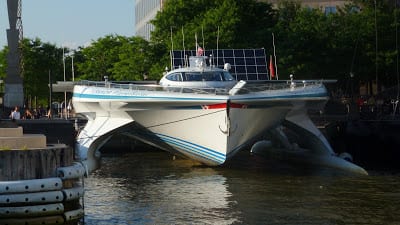Straight from the sun: The renewables revolution has landed
By Mike Robbins on 19 July 2013
The southern tip of Manhattan narrows to a point at its southern end and juts out into the broad expanse of New York Harbour. The Marina is on the lower West Side, far enough down for the famous landmark of Ellis Island to be clearly visible. Just beyond is the Statue of Liberty; it was a mid-June Monday and the statue was bathed in the bluish haze of a warm humid late afternoon at the end of spring. A few lazy sailboats drifted in front of it. Further away, the high, bright-orange superstructure of a Staten Island ferry passed in front of the Verrazano Narrows bridge, itself a tiny latticework on the horizon, spanning the channel between Staten Island and Brooklyn, and guarding New York’s gateway to the sea. Closer to the shore, the Circle Line sightseeing boat passed by, as did the odd ferry across the Hudson, carrying commuters home to the New Jersey shore a mile or so away across the river.Just after the latest round of climate change talks (in Bonn this time) had sort-of stalled, I took a walk to New York’s North Cove Marina.
The Marina itself is tucked into the steel-and-glass canyons of modern Manhattan; over it looms the new Freedom Tower that has sprung from the ruins of September 11 2001. That afternoon the MSTûranor Planet Solar had backed into her berth in the Marina after a long trip across the Atlantic to Florida and thence up the coast. The nameTûranor is taken from J.R.R. Tolkien; it is Elvish for Power of the Sun. They are not joking. Planet Solar is powered by an enormous solar array of about 5,600 square feet (519 sq m). Walking into the marina from the south, the 89-ton boat was instantly recognisable; she is actually a catamaran, with a totally flat superstructure bar a small blister for the bridge – the rest of her topside is solar cells.
The brainchild of Swiss eco-entrepeneur Raphael Domjan, in 2010-2012 she became the first solar boat to circumnavigate the globe. On this occasion, she had not come so far – across the Atlantic from La Ciotat on France’s Mediterranean coast. The trip had been accomplished solely on solar power; although she carries a back-up engine to recharge the batteries, she hadn’t needed it.
Planet Solar had not come to New York just to prove a point. On board was a team from the University of Geneva, led by Martin Beniston, Professor of Climate Change at the University and also director of its newly-established Institute of Environmental Sciences. On the night the Planet Solar arrived in Manhattan, the Swiss Consulate arranged a cheerful informal reception on board, and I found Professor Beniston unwinding with some excellent Swiss wines and cheeses.
Although Swiss, Professor Beniston was born in the UK and did his first degree at the University of East Anglia, where I did my own PhD on climate change. The project, he explained, was to carry out research in the Gulf Stream into the mechanics of CO2 fluxes between the ocean and the atmosphere, and especially into the role of phytoplankton. “Because it’s a pollution-free boat, it will be ideal for the collection and analysis of samples,” he told me. “They won’t be contaminated.”
Later I climbed up to the bridge to greet the captain of the Planet Solar, Gérard d’Aboville. The vessel had had a hard time docking that afternoon in the confined space of the marina, and he could have been in a foul mood, but he wasn’t, or if he was, he hid it well. But then, not much bothers a man who has rowed singlehandedly across both the Atlantic and the Pacific, sat in the European Parliament and done much else besides. (He also once competed in the Paris-Dakar with his four brothers, each one riding a Kawasaki 250; so maybe the whole family is slightly mad.) Then I stood with my companion in the hatch and admired the solar array, which glowed carmine and orange as the sun sank slowly towards the New Jersey shore, lighting the pink and grey clouds and setting the Hudson on fire.

No comments:
Post a Comment